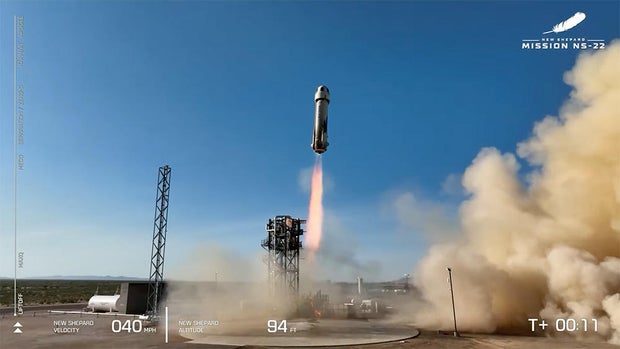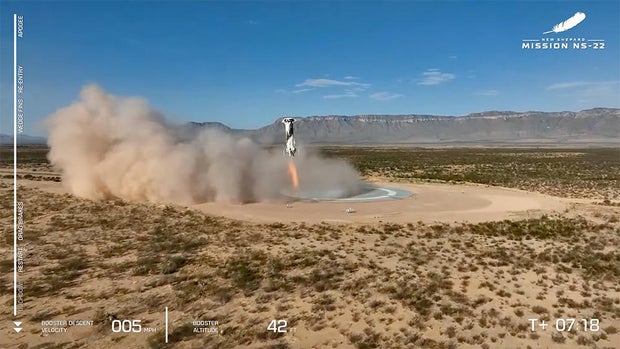Jeff Bezos says his trip to space humbled him
Jeff Bezos' Blue Origin launched its sixth New Shepard passenger plane on Thursday, sending half a dozen space travelers on a supersonic dash to the edge of space and back, after minutes of weightlessness and 66 miles above the sky. I thoroughly enjoyed the scenery that I do not think is of this world. West Texas.

As the spacecraft coasts to the highest point in its trajectory, microphones in the crew's cabin capture the euphoria and screams of surprise, and the passengers removed the strap. Floating in the air, I began to marvel at the spectacle of the earth spreading far below and the pitch-black space above.
"I'm doing it," cried one. "Oh my God." Another gasp. "Look at the blackness," someone shouted. One of his crew members gave me a little piece of advice.
The flight was brought to life by New Shepard's single-stage rocket, which took off from the Blue Origin flight facility in Van Horn, Texas at his nine o'clock. It started when At 57:00 EDT, it launches straight into a clear blue sky above a glorious jet of fiery exhaust gases.
Crew: Anglo-American climber, Egyptian space enthusiast, Portuguese investor and adventurer, telecom executive-turned-restaurant engineer, YouTube channel "Dude Perfect" co-founder of.
A hydrogen-burning BE-3 first stage engine propelled the New Shepard crew his capsule to a speed of 2,239 miles per hour and a final altitude of 351,232 feet. ” Between discernible atmosphere and space.
The capsule then arced back to earth. Shortly after the spacecraft's three main parachutes deployed and inflated, the crew joked loudly. Also "our poor family".
Mission duration from launch to landing: 10 minutes 20 seconds.
Sara Sabry is a 29-year-old Egyptian mechanical and biomedical engineer living in Berlin for her PhD. In aerospace science, flight time has never been as important as what it stands for.
"If you have the courage to dream big, you can achieve the impossible, push boundaries, write history, and set new challenges for the future." she told Space for Humanity, the organization sponsoring the flight.
“I am very excited that Space for Humanity has offered me this opportunity. You've dreamed and you've accomplished the impossible. Coby Cotton, one of the five co-founders ofDude Perfect, is also participating. Portuguese investor Mario Ferreira. Mountaineer Vanessa O'Brien. He is Clint Kelly III, an engineer with expertise in autonomous driving systems. Former CEO of a major telecommunications company, Steve Young is now a restaurant developer in Melbourne, Florida.

"I sold the company and got a lot of crazy money," Young told Florida Today. "And with ridiculous money you can do ridiculous things. I was always showing off and showing off, and what's better than being able to say you've been to space when you can't have a companion?" No."
Blue Origin did not mention the cost of the flight aboard New Shepherd. But Quartz reports that MoonDAO is a “decentralized autonomous organization” built on the Ethereum blockchain, where two of his New Shepherds, including Cotton, have invested $2,575,000 in his seat. i paid. The second seat has not yet been assigned.
"Thanks to the transparency of blockchain, we found MoonDAO cost him $2,575,000," he reported Quartz. "Part of that is transaction fees, but the numbers suggest that a seat in The New Shepherd would cost $1.25 million."
NS-22 mission led by Jeff Bezos and Richard Branson It was the twelfth manned commercial non-governmental suborbital space flight and the sixth for Blue Origin, an early leader in the fierce race between spacecraft. Billionaire owner of Virgin Galactic.

Branson said in 2018 when his company began its first pilot-tested flight over his 50-mile mark. , won the commercial suborbital space race. NASA and FAA. Branson boarded the company's fourth flight in July 2021 as a passenger. This was the latest flight, joining two pilots and his three Virgins his Galactic employees.
Bezos, his brother Mark, aviation pioneer Wally Funk, and his teenage Danish Oliver His Dayman will be on July 20, 2021 at Blue Origin. The first manned suborbital flight took off. Nine days after Branson's launch.
Virgin Galactic has yet to announce a date for its next flight, but Blue Origin will follow his Bezos flight with a series of his NASA experiments with unpiloted missions the following month. Did. Then, on 13 October 2021,William Shatner and his three crew members completed his 18th flight and his second passenger transport across the company. was launched at
December 11, 2021, his March 31st of this year, and most recently his June 4th, also saw his three manned New His Shepard flights.
Unlike Virgin's VSS Unity spacecraft, which is launched from a carrier jet, Blue Origin's New Shepard is a much more traditional rocket and capsule.
In just over two minutes, the single-stage boosters propel the capsule and its crew straight to an altitude of about 32 miles and a speed of about 2,200 mph before shutting down the main her engines.
After a few seconds, at an altitude of about 45 miles, the crew capsule will release and fly alone.
While the reusable boosters returned to land on a nearby pad, the crew's capsule continued upward on an unpowered ballistic trajectory, reaching a maximum altitude of just over 65 miles three-and-a-half minutes after takeoff. exceeds .
The Fédération Aéronautique Internationale (FAI), the Swiss-based international body that certifies aerospace records, considers an altitude of 100 kilometers (62 miles) to be the discernible boundary between atmosphere and space. increase.
NASA and FAA state that 50 miles is the point at which wings and aerosurfaces no longer affect the motion of the vehicle, thus defining the "outer space" starting point. Virgin Galactic uses that guideline and Blue Origin meets both criteria.
After being released from the New Shepard rocket, passengers experience approximately three minutes of weightlessness. That's enough time to unstrap and float around the cabin, enjoying spectacular views of the Earth from his six windows, which are nearly two meters high and over three feet wide.
Returning to the lower atmosphere, the capsule decelerates rapidly, subjecting the passenger to a momentary force more than five times his normal gravity. Three large parachutes then deploy and the craft slowly lands several miles away. launch pad.
Everything seemed to go like clockwork on Thursday.
- Jeff Bezos
- Virgin Galactic
- Blue Origin
- Richard Branson

Bill Harwood has served since 1984, first as United Press International's Cape Canaveral bureau chief and now as the head of the U.S. space program. I work full time. Consultant for CBS News. He covered his 129 space his shuttle his missions, every interplanetary flight since Voyager 2's Neptune flyby, and numerous commercial and military launches. Based at Kennedy Space Center in Florida, Harwood is a dedicated amateur astronomer and co-author of "Comm Check: The Final Flight of Shuttle Columbia."
Thank you for visiting CBS NEWS.
Create a free account or log in to
for more features.


